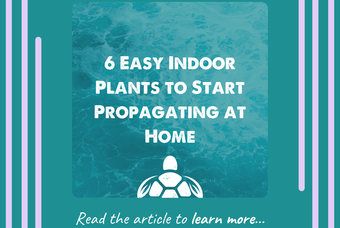The News-Hub/ Articles
Back to Articles
Recommended Articles
6 Easy Indoor Plants to Start Propagating at Home
If you think that sounds like a lot of plants, there are still thousands out there that haven’t been discovered! Right, time for another fun fact, did you know that 7 in 10 millennials call themselves a plant parent, which means they’re responsible for plant babies - also known as houseplants? Of course, it’s a completely different challenge to caring for actual babies - and much less demanding - but these indoor plants offer owners their own sense of purpose and joy.
This brings us to the main purpose of the article, which is to provide 6 suggestions on easy plants to grow and propagate at home with tips on how to get started, including propagating, planting and caring for your houseplants.
Benefits of growing plants at home:
-
Mental health, relaxation and reducing stress
There’s no denying the healing powers of nature with evidence to suggest that it’s associated with good health and wellbeing. This includes decreasing stress levels and of course, creating a home filled with houseplants may not be the same as walking through Kew Gardens, but these green beauties can relax your mind at the end of a busy day. This is supported by a study concluding that “interaction with indoor plants may reduce psychological and physiological stress by suppressing autonomic nervous system activity in young adults”. It could be linked to the soothing effect of indoor plants reminding us of the outdoors and nature
-
Interior design, adding colour and character to a home
The use of plants in modern interior design has become increasingly popular. While large indoor plants can be used to make a statement in the room, small plants boast versatility and low maintenance, making them ideal for any space. Also, plants are pretty, so adding them to your home can improve its aesthetics, while also injecting colour, ambiance, personality and fresh life into what might be otherwise bland spaces.
-
Plants and herbs that can be used for cooking
Herbs, the leaf part of the plant used in cooking, not only add colour and flavour to your meals, but they can also improve your immunity. For example, basil does this by purifying your blood and removing toxins. We have the perfect gift set for those looking to grow their own herbs.
-
Fresh smells and anti-pollution
When it comes to making your home smell fresh, fragrant houseplants are a nice alternative to artificial air fresheners and scented candles due to their natural and eco-friendly qualities. For example, Gardenia, the ingredient used in many perfumes, offers a sweet-smelling aroma that can keep your house smelling fresh for months. As well as producing delightful smells, this study states that potted plants could “reduce NO2 by as much as 20 per cent”.
How do you start growing plants at home?
The best things in life are free and this includes growing plants at home…to an extent. You just need some plant cuttings from existing plants, some old glass jars to propagate your plants, and some pots to eventually plant them in. You can also ask a friend to take some cuttings which is another free way to grow from scratch.
If you want to avoid all the old jars dotted around the house for your plant cuttings, you could consider an elegant plant propagator stand, which adds character to any house.
How do you start propagating your plants?
Plant propagation is the process of creating new plants from a single parent plant. There are a range of techniques including division, budding and cutting but the latter is the least risky to the parent plant.
Cutting involves taking cuttings from a plant, putting them into water, waiting for the cutting to grow roots, and then planting them in soil. Our plant propagation gift set will get you started if you’re looking for something to buy that looks nicer than using old glass jars around the house.
Below is a quick step-by-step guide on how to do it:
- Choose the part of the plant where you’ll snip your cutting. Try and find the root node of the plant.
- Use a sharp knife or scissors to cut just below the node. Aim for about 1/4″ below.
- Add your cutting into a clean glass with enough room temperature water to cover the nodes.
- Change the water every 3-5 days, ensuring its fresh room temperature water.
- Sit back and watch your roots grow which could take weeks or months depending on the plant.
- As soon as your roots reach approximately 3″-5″, it’s time to plant the cutting in soil!
6 easy plants to grow at home:
No.1: Snake Plant
The snake plant, also referred to as the Sansevieria trifasciata, is native to Asia and Africa and there are around 70 different species. With evergreen sword–shaped leaves, it's easy on the eye and makes a nice addition to any home.

Credit: cactusway.com, hedgerose.uk and bhg.com
As well as being relatively easy to grow, the snake plant is also an extremely tolerant indoor plant that’s hard to kill, meaning it can survive drought and lack of exposure to light. The straightforward plant care involved makes it ideal for any beginner.
-
How fast should a snake plant grow?
It’s a slow-growing plant so you may need to be patient as it can take between 6 to 8 weeks to see any root growth. When growing the snakeplant cuttings, we recommend avoiding low-light areas which will slow growth. It may then take another 4 to 8 weeks for the plant to grow above the soil line.
-
How big do snakeplants get indoors?
A healthy indoor snakeplant can reach up to 8 feet high indoors, while its width can range from 6 inches to 3 feet.
-
Where can I buy a snakeplant?
B&Q has a snake plant in a 14cm pot.
No.2: Pothos Plant
The pothos plant, native to southeastern Asia, has heart-shaped green leaves and it's also known as the ‘hanging plant’ with aerial roots that allow it to climb.

Credit: crocus.co.uk, bunches.co.uk and justhouseplants.com
It’s considered to be one of the easiest houseplants to care for as it can grow in a plethora of environments, such as bright, indirect and low light. It is also said to be one of the best indoor plants for removing air toxins, as supported in this study by NASA.
-
How long does it take for a pothos to grow?
The pothos is popular for being one of the fastest growing indoor plants but it needs the right conditions such as sunlight, water and nutrients to flourish. From a cutting in water, it can take about a month for it to grow inch-long roots. The cuttings will then grow their first leaves in 4 to 5 months, depending on the right level of nutrients.
-
How big can a pothos get?
In wild conditions, a pothos can reach incredible sizes but at home, they’re usually much smaller. Mature leaves can range between 4-8 inches, while the vine is likely to not grow more than a couple dozen feet.
-
Where is the best place to buy a pothos?
Waitrose has devil's ivy Golden Pothos.
No.3: Dracaena
For Game of Thrones fans, the name Dracaena derives from the Greek word “drakaina”, which means female dragon. But in the world of plants, these are slightly different from fire breathing dragons.

Credit: waitrosegarden.com, bloomscape.com and thespruce.com
These popular ornamental houseplants with spear-shaped leaves, known as the Dracaenas, include 120 species within the Draceana genus and have origins in Madagascar and other Indian Ocean Islands. Dracaena houseplants are also drought tolerant, making them easy plants to grow at home.
-
How fast do Dracaena plants grow?
Of course, it depends on the species and dracaena care but generally speaking, they are slow growing and it can take up to 10 years for them to reach their highest point. For example, Dracaena marginata grow extremely slowly with about 12 inches in three years, according to reports.
-
How big do Dracaena houseplants get?
Dracaenas can grow as big as 6 feet high indoors.
-
Where can I buy a Dracaena?
Gardens4You have a variety of plants on offer, including the Dracaena Marginata.
No.4: Jade Plants
Jade Plants, a sub-shrub native to southern Africa, can be compared to bonsai trees with their green, fleshy leaves and thick stems. They’re also said to be symbols of good luck.

Credit: gardendesign.com, dengarden.com and gardeningknowhow.com
It’s a succulent houseplant which means it's resilient and easy to grow indoors, making it an ideal plant for beginners. Part of this resilience comes from the fact it is able to store water in its leaves, allowing it to cope with drought.
-
How long does it take for a jade plant to grow?
Jade plants are slow growing and can grow by about 2 inches per year but this can be influenced by many factors. We therefore recommend optimising care conditions to help it grow faster. For example, this plant loves thriving outdoors in full sun.
-
How big can jade plants get?
They can reach between3 and 6 feet tall so you may need to repot depending on the rate of growth.
-
Where can I buy a Jade plant?
Waitrose sells high quality Jade Plants , including the Crassula Ovata.
No.5: Spider Plants
If you’re scared of spiders, please don’t panic…it’s just a plant. The spider plant, also known as “chlorophytum comosum”, comes from the tropical and subtropical regions of Africa, Asia, and Australia. Its name derives from its spiderettes, which resemble spiders on a web when they dangle from the mother plant.

Credit: thespruce.com, Garden Market Place Amazon Store and bloomscape.com
It’s not only one of the most adaptable indoor plants, it’s also incredibly easy to grow in a range of conditions. We recommend well-drained soil and bright, indirect sunlight to allow this plant to flourish.
-
Are spider plants fast growing?
Spider plants grow quickly and will usually need to be repotted into a bigger pot about once every 2 years.
-
How big do spider plants get indoors?
This plant can grow up to 1 or 2 feet tall.
-
Where can I buy a spider plant?
B&Q is selling affordable spider plants.
No.6: Monstera
Native to tropical America, the Monstera are a species of evergreen tropical vines and shrubs. They’re renowned for their natural leaf-holes which explains their nickname, the “Swiss Cheese Plant”.

Credit: mytastefulspace.com, Polsada Etsy Store and petalrepublic.com
Monsteras prefer warm, humid environments which explains why they make good houseplants. Although they can survive in low light, it’s best to expose them to bright, indirect sunlight which will boost growth.
-
How fast does monstera grow indoors?
Healthy plants tend to grow between 1 to 2 feet per year in the right conditions.
-
How big can monstera plants get?
In the right conditions, Monstera deliciosa can grow up to 10 to 15 feet tall indoors and stretch 8 feet wide.
-
Where can I buy a monstera?
Waitrose is selling a medium 40cm Monstera deliciosa swiss cheese plant.
What do plants need to grow?
-
Space
The leaves and roots need sufficient room to grow. While leaves need space to absorb sunlight, the roots need to be able to spread out to absorb water and nutrients. Plants shouldn’t be planted too close together, otherwise they’ll compete for these essential resources.
-
Temperature
It’s crucial for plants to have the right temperature at the right times to be able to grow. This is due to photosynthesis, the process where plants convert energy from the Sun into energy they can use, which can only take place optimally at the correct temperature. This process allows the plant to create oxygen and glucose for itself, which are essential building blocks for growth.
-
Light
Although plants can get light from the Sun to grow, they can also grow in artificial light. The light energy is used to make glucose which acts as their energy source.
Without enough light, the plant will grow extremely slowly but too much light could result in the plant drying out. For example, although the pothos plant can flourish in a range of conditions, it doesn’t enjoy exposure to direct sunlight.
-
Water
Water is needed for plants to carry out photosynthesis. Once absorbed by the roots, water moves through the stems to the chloroplasts in the leaves. Water also helps move important nutrients from the soil into the plant.
Without water, a plant will droop but too much watering can cause the roots to root. A good example is the spider plant which only needs to be watered about once a week.
-
Air
Just like humans, plants need oxygen to survive. During the process of photosynthesis, plants absorb CO2 (Carbon Dioxide) from the air and combine it with water from their roots. The energy from sunlight is then used to transform into carbohydrates (sugars) and oxygen.
-
Nutrients
In addition to CO2 and water, plants need 17 nutrients in their diet for maintaining growth. Carbon, oxygen and hydrogen can be obtained from the air but most of these nutrients must be in the soil. For example, nitrogen, phosphorus and potassium are nutrients that can be dissolved in water so the plant’s roots absorb them.
You could look into using a fertilizer if your plant is unable to access the nutrients it needs. They’re designed to provide essential nutrients which help plants grow faster.
How to care for your plants?
-
How to spot if houseplants are dying
For those striving to be great plant parents, please read on. The great thing about plants is they communicate with us which makes caring for them not too difficult. But telltale signs that your houseplant is dying include yellowing leaves, browning leaves, a dull looking foliage, roots that stick out and spots on its leaves.
However, don’t lose hope as you could still bring them back to life! For example, leaves that turn yellow indicate an issue with overwater so moving forward, don’t be so generous with the water and cut of the damaged foliage
-
How often should you water houseplants?
Most houseplants should be watered every 1 to 3 weeks. We recommend monitoring them and giving them a drink when needed. How often you choose to water them depends on different factors such as the type of plant, size, type of pot etc.
For example, you’re meant to water a pothos plant when the soil dries out but this differs from a spider plant where the advice is to only water when the top 50% of the soil is dry. Just do your research!
-
Where to place houseplants
Houseplants love getting them rays but most are happy with bright, indirect light. They don’t need to be exposed to direct sunlight at all possible hours of the day as this could damage their leaves and roots. Most plants will therefore be content with a window that’s East, South or West facing.
- When to repot a houseplant into a larger pot
At some point, you will need to repot your houseplant. Even the snakeplant - which doesn’t mind cosy conditions - has roots that outgrow its pot. The best time to repot your houseplant is during spring and summer when it's in active growth. You want to give the growing roots sufficient time to grow into the new pot.
Next steps for future indoor plant owners:
We hope you have learnt some cool new tips on how to start, or progress on your plant growing journey. Thanks for taking the time to read our article, but feel free to leave your top tips in the comments below!
1 comment
Empty content. Please select category to preview











Where is, or what is the “root node?” It would have been good to show some example to those new to this game.